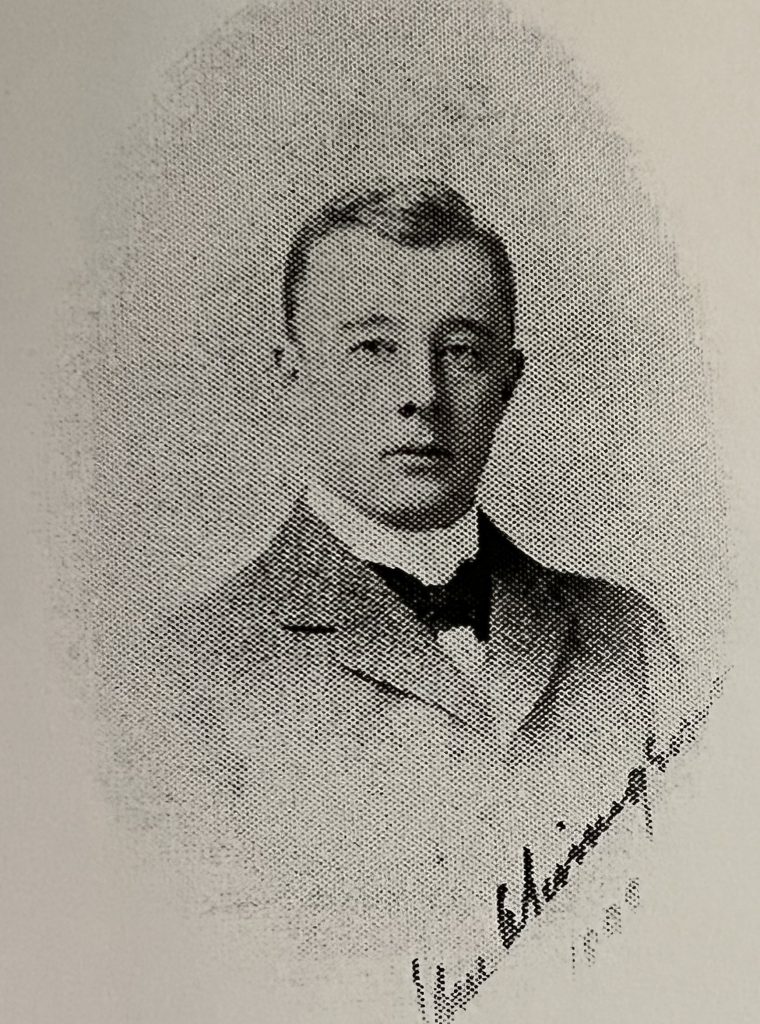John Alexander Scrimgeour (2 May 1872 – 27 November 1925) was a wealthy stockbroker who inherited the Manor of Stedham in (West) Sussex from his mother on reaching his 21st birthday. He used his considerable wealth to improve the lives of his tenants on the estate and to provide homes and facilities in Stedham, leaving a lasting mark on the village.
Family background
John Alexander Scrimgeour was born on 2 May 1872 at Woodside in Jackson’s Lane, off Archway, Highgate in north London, the second son and youngest of eight children born to Alexander Scrimgeour (1835–1882) and his wife, Anne Esther née Duguid (1832–1892). He was baptised at the family church, St. Michael’s in South Grove, Highgate, on 10 July 1872. Alexander Scrimgeour was a founding partner in J. & A. Scrimgeour, one of the leading firms of stockbrokers in London.
At the 1881 census, the family were living at 1 Queen’s Gate, Kensington (close to Kensington Gardens), with a governess, butler and 12 other staff. 9-year old John was recorded as a scholar.
Alexander Scrimgeour had built their new Sussex home, Wispers, near Stedham in 1874/76; after his death in February 1882, Anne Esther Scrimgeour moved to Wispers where she was living with six of her children in April 1891. At the time of the April 1891 census, 19-year old John was a guest at the rectory at Cottingham, Northamptonshire, where he was recorded as a student, together with 17-year old Edward Allen Robinson from Burnley, Lancashire. Their host was Revd. William Yates, rector of St Mary Magdalene, Cottingham.
John attended Charterhouse School from where he matriculated in October 1891 before going up to Christ Church, Oxford, where he was admitted as a commoner. There is no record of John Alexander Scrimgeour having graduated from The University of Oxford.
John’s mother died at Wispers on 14 January 1892, aged 59, when John was only 19. In her will, she divided the estate at Stedham between her two sons, with John (on attaining 21 years of age) inheriting Stedham Hall and the manorial rights, plus property in the Manor of Stedham to the south of the River Rother, and cottages in the villages of Woolbeding and Iping to the south of the River Rother. Thus, John became Lord of the Manor of Stedham.
At the time of his marriage in January 1898, John gave his occupation as a stockbroker.
Professional career
John was admitted as a member of the London Stock Exchange in February 1898, following which he was admitted as a partner in the family stockbroking firm, J & A Scrimgeour, trading from South Sea House, Threadneedle Steet, and later from Broad Street and Hatton Court, all in the City of London. The firm specialised in the floating of Government and Dominion loan stocks.
By the time of his death, John had risen to become senior partner in the firm, and served on the committee of the Stock Exchange.
Marriage and family
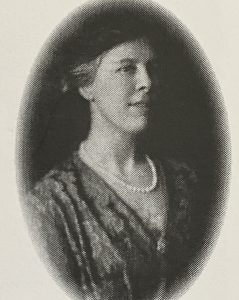
On 6 January 1898, at the Free Church College, Glasgow, John, aged 25, married 25-year old Jessie Constance Greig (“Connie”). Constance was the daughter (third child of eleven) of David Greig (1835–1900), a “foreign merchant”, and his wife, Constance Turnbull née Thomson (1844–1915). Among Constance’s siblings was Louis Leisler Greig (1880–1953), who became a member of the Scrimgeour family stockbroking firm, and a close friend and confidant of King George VI. In 1916, Louis Greig married Phyllis Scrimgeour, John’s cousin by his uncle, Walter.
John and Constance only had one child, Annie Esther, born at Guildcroft, near Guildford on 6 December 1898. She was baptised at St James’s Church, Stedham on 2 April 1899, when the family gave “Wispers” as their address.
At the time of the March 1901 census, the family were living at The Rectory, Wickhambreaux, Kent with John’s elder brother, Alexander Carron Scrimgeour and his family, although John gave his address as “The Cottage, Gatton, near Reigate, Surrey” when applying for renewal of his membership of the Stock Exchange that same month. He continued to use the Gatton address until 1912, when he acquired the property at “Godstone Court, Godstone, Surrey”.
Stedham Hall
In May 1893, on attaining the age of 21, John inherited the property at Stedham Hall , following his mother’s death in January 1892. The hall had been acquired by Alexander Scrimgeour in the mid-1870s, at about the time he acquired the rest of the Stedham estate.
The original house was built in about 1520-1525. From 1845 to 1870, the house was owned by John Stoveld (1797-1870). He was a banker in Petworth, trading as Stoveld & Co., who were the first bank to issue Bank of England notes rather than their own. He sold the bank to London & County Banking Co (now part of National Westminster Bank) in 1845, and moved to Stedham.
Shortly after acquiring the hall, Stoveld set about “modernising” it by the addition of many Victorian features, covering the original timbers and brickwork with stucco, and replacing the ancient windowpanes with plate glass windows.
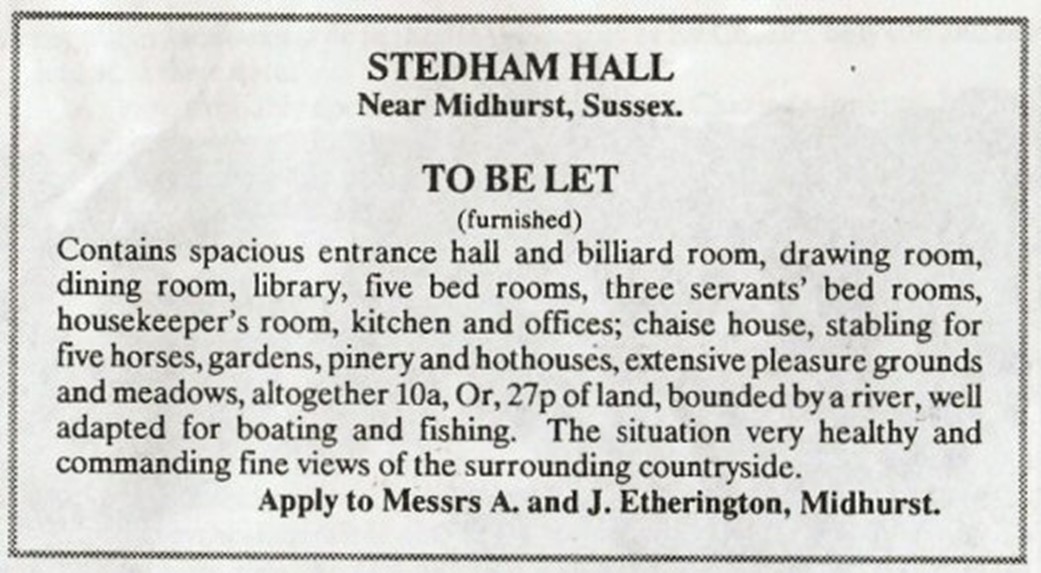
Following Stoveld’s death in 1870, the property was leased by the trustees of his estate to Revd. Phelpes John Butt (1797–1883), who had left by 1881, when the tenant was Henry Billinghurst (1822–1915), a retired doctor, who continued to live there until 1910. Billinghurst’s son, Henry Godwin Billinghurst was rector at Linch, a few miles north of Stedham, from 1883 to his death in 1912.
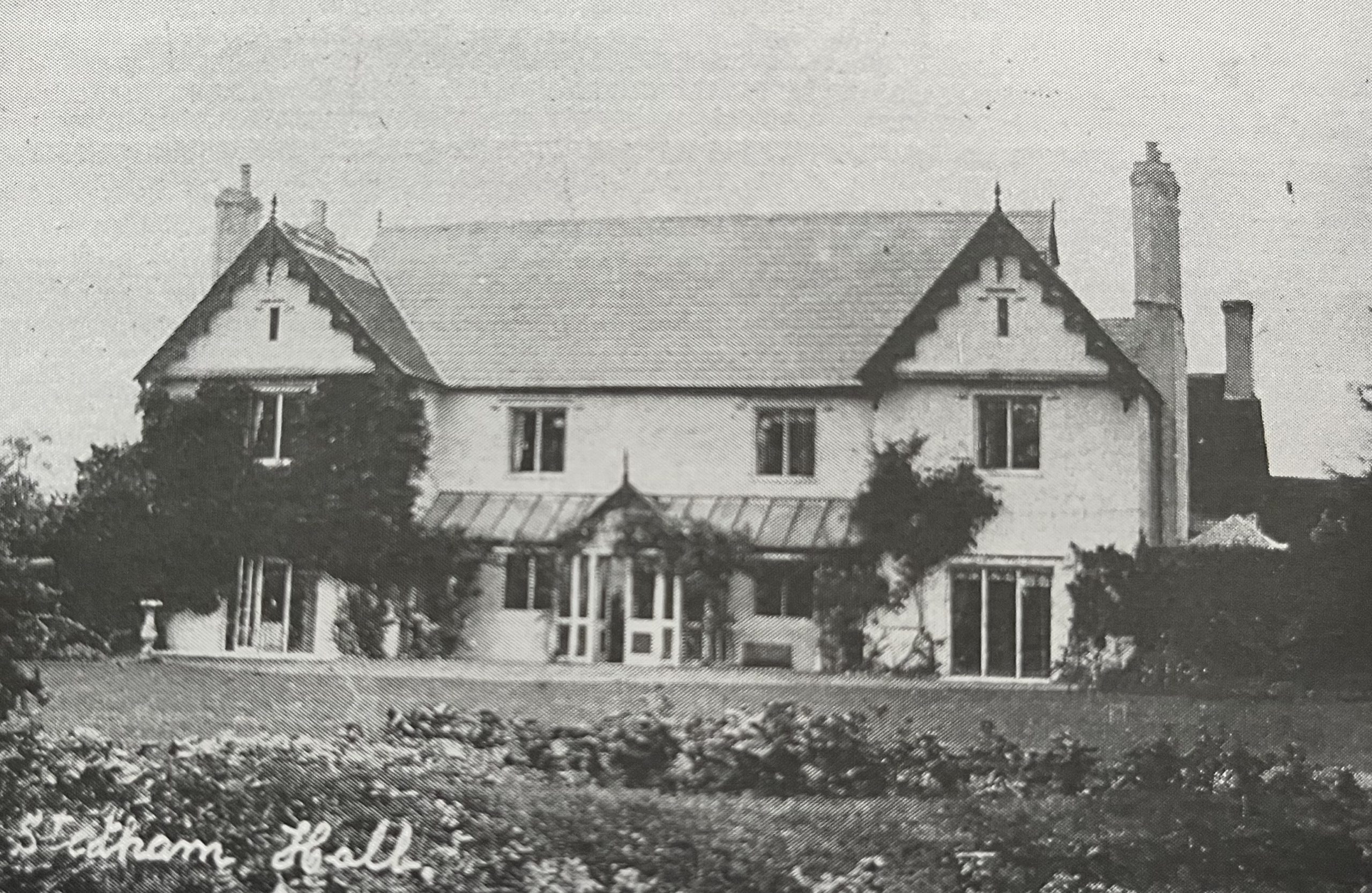
John and Constance Scrimgeour were not able to take possession of the hall until the end of Billinghurst’s lease in 1910. They appointed John Malcolm as architect who set about restoring many of the original features, adding a northern extension. and refacing the house with half-timbering and sandstone.
Writing in the Sussex County Magazine in June 1934, Lady Frances Wolseley said:
Stedham Hall is an example of an old house that has passed through a phase of mishandling when its original beauty was well-nigh destroyed. Fortunately for the people of Sussex, the harm that was done by Mr. Stoveld was corrected by the good taste and skill of Mr. Scrimgeour when he inherited the property in 1910(sic)..
The work undertaken by the late Mr. Scrimgeour when he inherited the property was a lengthy one for it meant the demolition of the Victorian atrocities and the restoration upon truly artistic lines of what the 16th century builders had carried out. The labour of love, undertaken with the supervision of the architect, the late John Malcolm, took some years to accomplish. It was not until 1915 that Mr. & Mrs. Scrimgeour were able to inhabit Stedham Hall, restored as we find it today.
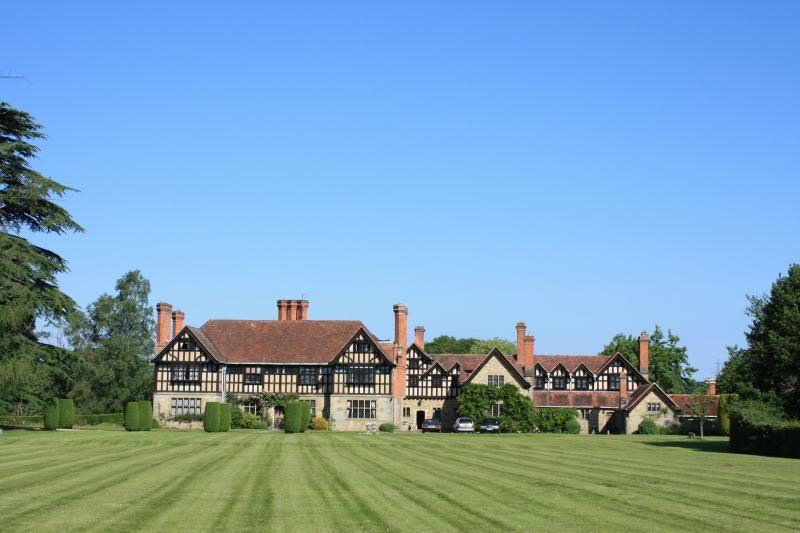
Pevsner describes the hall as “an impressive Neo-Elizabethan rebuilding … more picturesque than the original was before remodelling”. The hall is not a listed building.
First World War
On 5 March 1917, John was commissioned as second lieutenant in the Surrey Volunteer Regiment, later the 2nd Volunteer Battalion, Royal West Surrey Regiment. After the war, he retained the rank on an honorary basis.
Lord of the Manor of Stedham
John Alexander Scrimgeour became Lord of the Manor of Stedham in 1892 (aged 19) on the death of his mother.
Although they only took up residence in Stedham Hall in 1915, John and Constance had the use of Wipers when visiting the manor. Similarly to John’s parents, they took an enlightened view of their responsibilities as Lord and Lady of the Manor.
In Stedham & Iping Remembered (2012) by Christine Dicks, Colin Dunne and Sanchia Elsdon, Julia Hall, the granddaughter of John and Constance Scrimgeour, recalls:
Both my great-grandparents and grandparents have been benefactors to the village people of Stedham. They built many of the cottages and gave the occupants a piece of land each on which to keep a pig, sheep, chickens etc. if they so wished. They installed three baths in the Collins Club for use by those who did not have such a facility in their own houses. They also gave 150 books for a small library.
I remember my grandmother, Jessie Scrimgeour, very well. I used to go into her bedroom when she was having her breakfast in the morning (in bed because she was elderly and not very well) and I was allowed to go through her dressing table at look at all her things.
In November 2017, Stedham & Iping Parish Council published their Review of Heritage Assets as part of the Neighbourhood Plan. This listed 29 groups of buildings within the parish that were considered to be “heritage assets”; of these, eight had been provided by members of the Scrimgeour family. These include:
Christmas Cottages, School Lane:
Significant for their picturesque Arts-and-Crafts style of architecture and as evidence of the philanthropy of the Scrimgeour family, at whose expense they were built in about 1936.
Linden and The Little House, The Street
Formerly Greathouse Farmhouse; the most elaborate and characterful of the houses built by the Scrimgeour family of Stedham Hall.
9 & 10 The Street and 11 & 12 The Street
Two pairs of cottages in The Street which exemplify the impact of the Scrimgeour family on the development of Stedham between 1876 and 1950. One of two pairs of attached farm cottages in The Street built by Alexander Scrimgeour or his widow for workers on Greathouse Farm. Each dwelling was provided with about ¼ acre of garden beside it. One of the distinctive Scrimgeour buildings which punctuate The Street and provide a 19th-century matrix into which later houses have been inserted.
Lavender Cottage, The Street and 1, 2 & 3 Aubrietia Cottages
Probably built by the Scrimgeour family c.1925. Distinctive design, linked by its materials and Arts-and-Crafts irregularity to other buildings erected in Stedham by the Scrimgeour family, also by the provision of space for growing vegetables, in this instance in front of the house.
The Reading Rooms & Collins Cottage, The Street
Of historic and cultural interest for its conversion in 1884 from an 18th-century barn into a Recreation Room & Library at the expense of Mrs. Alexander Scrimgeour; later a bath house and finally, a club with a bar and a snooker table.
The Memorial Hall, Stedham
Of historic and cultural value as the former Women’s Institute Hall and, since 1947, as the Stedham War Memorial; built on land given to the village in about 1912 by John Scrimgeour for use as a .22 rifle range.
In June 1925, a new sports pavilion was opened on the village sports field, provided by John Scrimgeour. On 11 June, the West Sussex Gazette reported on the opening ceremony:
This village is probably the happiest … in the Midhurst rural district, and the secret of its happiness is the generous encouragement given in social activities and daily lives by the Squire, Mr. J. A. Scrimgeour. Council cottages are unknown and unnecessary in Stedham, because Mr. Scrimgeour does all that is necessary in the building line. He has put up ten houses since the war, and four more are shortly to be built. Of artistic design and substantially built, these on the left going into the village from the Petersfield road have fine gardens.
Two years ago, all the sports organisations in the village amalgamated as the Stedham Sports Club, with Mr. Scrimgeour as president, and today the club boasts of a six acre ground in the centre of the village, the only indebtedness to the Squire being a nominal rent.
Death and tributes
In November 1925, John was taken ill with persistent headaches and earache, and was admitted to a nursing home at 4 Dorset Square, near Regents Park, London. Although he underwent three operations on his ear, his health continued to deteriorate and he died on Friday 27 November, aged 53. His death certificate records the cause of death as “Mastoid abscess (1 month) [and] cerebral embolism (5 hours)”. Although he had been ill for several weeks, the news of his illness did not reach his family until late on the day before his death, with the news coming as a shock to the people of Stedham.
His funeral was held at St. James’s Church, Stedham (adjacent to Stedham Hall) at 12:00 on 1 December 1925; at the same time, a memorial service was held at St. Michael’s Church, Cornhill. His funeral was attended by nearly 200 people, many of whom were unable to get into the church. The coffin was carried from Stedham Hall to the church on a farm wagon, drawn by a pair of horses. Escorted by all the estate workpeople and servants, together with about 70 ex-servicemen and villagers. The coffin was carried into the church by eight members of his staff, and later lowered into the grave by his brother and seven other members of his family. He was interred close to his parents in the family plot in Stedham churchyard.
During the service, Revd. D.W. Hodgson said that John’s passing was “a calamity for Stedham. I’m certain that no parish has, or ever had, a greater benefactor.”
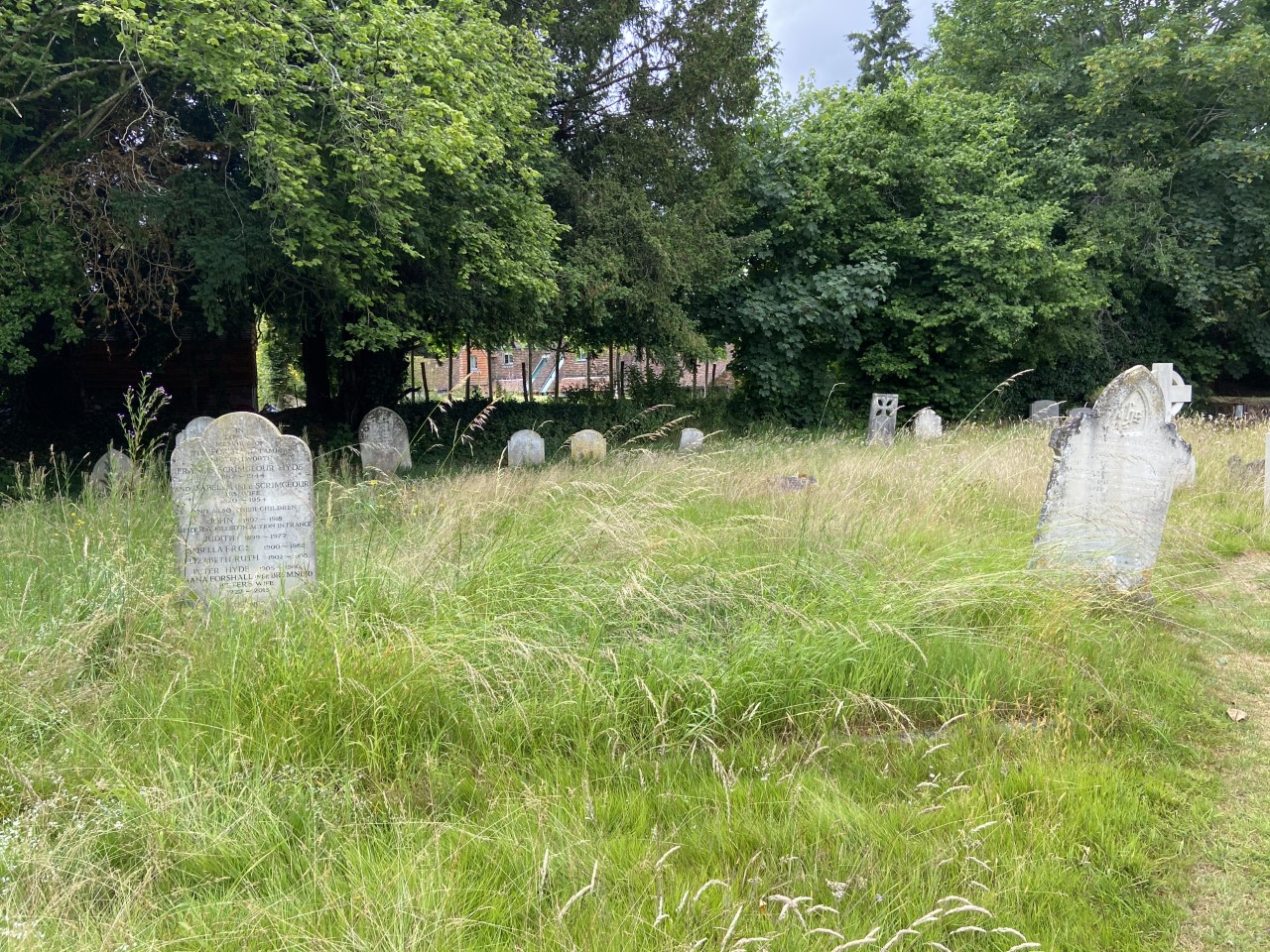
Tributes were paid to him in many newspapers, both local and national. On the day after his death, The Times reported:
Mr. Scrimgeour had played an important part in City life. A member of an ancient Scottish family … after leaving Oxford, he entered the stockbroking firm of which his father and other members of his family were partners, and settled down to the business career which had always been his ambition.
For many years, he had been the [firm’s] senior acting partner. Hence, Mr. Scrimgeour’s position called for an exceptional knowledge of financial conditions and for rare judgement. Being a man of abundant energy and enthusiasm, he very seldom allowed his own special duties to be discharged by others. In spite of the heavy claims made by the business of his firm, he found time to assist in the domestic running of the Stock Exchange. He was for some years … a valued member of the Stock Exchange committee.
His interest in the cause of charity had shown itself in his work for the Stock Exchange Benevolent Fund, on the committee of which he had at one time sat. This side of his nature was perhaps better illustrated by those many acts of kindness of which there is no record other than that left with the smaller and older members of the Stock Exchange who received his helping hand when in need.
The West Sussex Gazette of 3 December opened the report of his death with the words:
Not old in years … and possessing the temperament, the joviality and the good nature of the old type of country squire …
The grief of his relatives is shared by all in Stedham and the neighbourhood. Mr. Scrimgeour was everybody’s friend and knew most of them by their Christian names.
He was quiet, unassuming, and always shrank from publicity, especially publicity about his generous gifts, of which there were many. Stedham knows no dearth of cottages, thanks to the generosity of Mr. Scrimgeour, who built wisely and well, always with a keen eye on architectural beauty. His cottages are an ornament to the countryside. He put electric light in the Parish Church, and recently had water laid on to all the houses in the village. One of his most valued gifts was the Sports Field, which was glebe land before he bought it. Few small towns can boast of such an asset.
“Let us know what is wanted” was Mr. Scrimgeour’s greeting when the rector first came to the parish, and that aptly describes his spirit and the quality of his large heart.
He had never been known to refuse financial assistance and in this, and many other ways, he showed his gratitude to the ex-servicemen in the village. Yearly, he entertained them to dinner, and was always present.
He was a strong Conservative … and a keen supporter of the Chichester Divisional Association. The Duke of York and Prince Henry have often been guests at shooting parties at Stedham, and [he] has also welcomed members of the Royal Family at Godstone Court, Surrey, which he lent during the war as a military hospital.
As a sportsman, [he] was very keen on hunting. He was also fond of cricket. lawn tennis, fishing and shooting.
The Times of 2 December reported on the memorial service at St. Michael’s Church, saying that it …
provided eloquent testimony to the high regard in which he had been held by the city. The famous old City church has seldom held a larger or more representative body of Stock Exchange men, and the simple dignity of the service and the impressive address by the rector made the gathering one that will long live in the memory of those present.
The Stock Exchange has always been fortunate in possessing among those who those who take the lead in the conduct of its affairs, men whose own high standard of conduct is a worthy example to his fellows. That Mr. Scrimgeour came within that category will be readily conceded by all who knew him.
On the same day, The Times published a letter from Mr. J.W. FitzWilliam of Easebourne Rectory:
I think it can be said without fear of contradiction that no man could be more missed than [John Scrimgeour] will be for many miles around here. With Mrs. Scrimgeour … he showed kindness by word and deed, many of which may never be known. Stedham in recent years had become the centre of a great network of kind actions inspired and carried out, whenever possible in secret, by him who has left us.
In the few short years of his life, he accomplished all the good that can be required of any mortal. Upright, straightforward, and perhaps outspoken, he accompanied every deed and word with a gentle smile. He was blessed with much that was considered good of this world, but no one could have shared his joys more fully with those less fortunate than himself, and to count those into whose lives he brought unexpected happiness would be an impossible task. They are among the many who are sorrowing with his nearest and dearest.
Reports of his death also appeared as far away as New Zealand. On 9 January 1926, The Evening Post (Wellington) reported as follows:
Although not unprepared for the sad event, the Stock Exchange … learned with profound regret of the death of Mr. John Alexander Scrimgeour. Doubtless to many businessmen in New Zealand, Mr. Scrimgeour will be well known personally.
His ability and high character … won for him the respect and … affectionate regard … of a very wide circle in the city. His death leaves a gap in the rank of first-class members of the Stock Exchange which will be hard to fill.
Thoroughness was the keynote of his success. While immersed in the finances of corporations of colonies and corporations involving millions of money, the smallest details of his office never escaped his attention. Of his charity, which was great, it is difficult to speak since he chose, as most good men do, the least ostentatious methods of tendering assistance to those in need.
A man of great impetuosity and quick perception, he was admired by colleagues and subordinates alike.
In 2017, Colin Dunne wrote an article in the Daily Mail “Farewell to my English village idyll”, extolling the virtues of life in Stedham.
While other squires were out raping maidens and oppressing the poor, or so legend has it, John Scrimgeour, the lord of the manor who lived at Stedham Hall, occupied himself instead with spreading cheer and happiness in the village he owned.
At the end of Queen Victoria’s reign, he was busy putting in the village’s water supply and installed a bathhouse and a reading room for his tenants. He gave the villagers an eight-acre playing field, and he built three-bedroom houses for newlyweds.
The ghost of the great benefactor is still here. In May every year, the old walls of the village are bedecked with purple aubrietia — John Scrimgeour’s favourite flower.
Constance Scrimgeour continued to live at Stedham Hall until her death on 18 July 1943, aged 71. She was buried alongside her husband five days later.
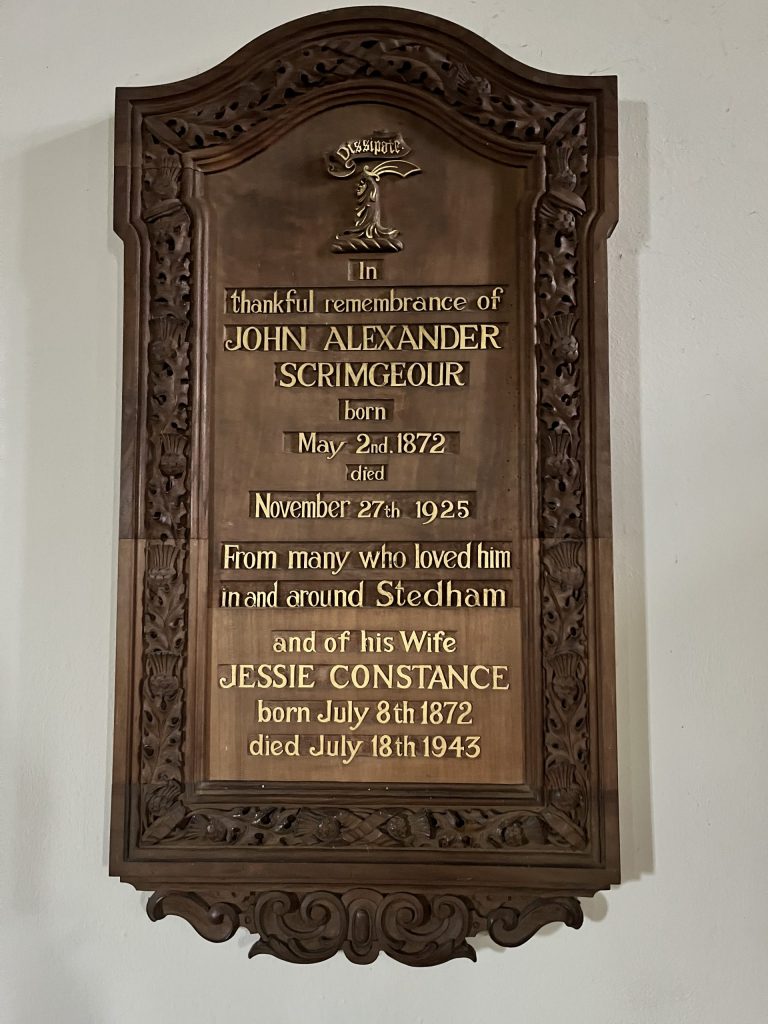
After the death of Constance, the estate was broken up and sold off in 1950. Before the final sale, each tenant was given the chance to buy their home on favourable terms, and the freehold of the sports field and the Collins Club were given to the village. Subsequently, Stedham Hall was converted into apartments.
Annie Esther Scrimgeour and family
John and Constance’s daughter, Annie Esther Scrimgeour married Captain Arthur Edward Russell, M.C. at Stedham church on 15 April 1920, when she was 21 and he was 35.
Prior to the First World War, Arthur Russell had been a partner in the firm, Wedd, Jefferson & Co,. stockbrokers. At the outbreak of the war, he enlisted as a trooper in the London Yeomanry, before being commissioned as a second lieutenant with the 3rd Battalion, Gordon Highlanders on 3 February 1915. In April 1916, now attached to the 2nd Battalion, he was awarded the Military Cross. The citation in the Edinburgh Gazette reads:
For conspicuous gallantry on patrol duty. He remained with a wounded man in a crater close to the enemy, avoiding the bombs, and at dusk completed his reconnaissance and brought in valuable information.
After being wounded three times, and losing a leg, he was invalided out and admitted to the hospital at Godstone Court, where he first met Annie Scrimgeour.
After their marriage, the couple lived at Itchenor House, West Itchenor. The couple had three children before Arthur died on 5 March 1929, aged 43. He was buried in the Scrimgeour family plot at Stedham church.
Annie, aged 36, remarried on 5 December 1935, at All Souls’ Church, Langham Place in Marylebone to 24-year old George James Stewart Chatterton, a pilot in the Royal Air Force. The couple had one child, a daughter Julia, born in 1939. In the Second World War, George rose to become commander of the Glider Pilot Regiment, being awarded the DSO in 1943. After the war, he became chairman of the Lady Hoare Thalidomide Trust. He was appointed OBE in the 1980 Birthday Honours. [For details of his military career see the Glider Pilot Regiment website.]
Annie died in March 1984 and George in November 1987. Both were buried in Stedham churchyard. Their daughter, Julia, married Alister Hall in 1963.
Sources
Ancestry.co.uk:
1881 England Census
1891 England Census
1901 England Census
1911 England Census
1939 England and Wales Register
Charterhouse Register 1872–1910
England & Wales, National Probate Calendar (Index of Wills and Administrations), 1858–1966
London, England, Births and Baptisms, 1813–1906
London, England, City Directories, 1736–1943
London, England, Electoral Registers, 1832–1965 London, England, Marriages and Banns, 1754–1921
London, England, Stock Exchange Membership Applications, 1802–1924
Oxford Men and Their Colleges, 1880–1892
Scotland, National Probate Index (Calendar of Confirmations and Inventories), 1876–1936
Surrey, England, Electoral Registers, 1918–1945
UK, City and County Directories, 1766–1946
West Sussex, England, Church of England Births and Baptisms, 1813–1920
West Sussex, England, Church of England Deaths and Burials, 1813–1995
West Sussex, England, Church of England Marriages and Banns, 1754–1936
West Sussex, England, Electoral Registers, 1832–1963
Daily Mail. 9 March 2017. Dunne, Colin. Farewell to my English village idyll.
Daily News (London). 28 November 1925. Mr. J.A. Scrimgeour. Prominent city man dies after short illness.
Edinburgh Evening News. 7 January 1898. Marriages
Elsdon, Sanchia & others (2012). Stedham & Iping Remembered, a Walk Back in the Past Through Two Villages
Evening Post (Wellington). 9 January 1926. In the City
Geograph: The Collins Club, The Street, Stedham
Hampshire Telegraph. 15 March 1929. Capt. A.E. Russell M.C. Well known Itchenor resident’s death.
London Gazette.
Issue: 29993. Page:2 764. 20 March 1917
Supplement: 31414. Page: 7922. 20 June 1919
Issue: 33132. Page: 1116. 12 February 1926
National Westminster Bank: John Stoveld & Co
Pevsner Architectural Guides: Buildings of England. Sussex, West. May 2019. Yale University Press ISBN:978-0300225211 p.631.
Stedham Angling Club: Club History
Stedham Village Hall: History of Stedham Village Hall
Stedham with Iping Parish Council:
Review of Heritage Assets (November 2017)
Stedham with Iping Neighbourhood Development Plan (May 2021)
Sussex Agricultural Express. 10 December 1898. Births
Sussex County Magazine. June 1934. Stedham Hall, Midhurst, Viscountess Wolseley
Timen Stiddem Society: Stedham Hall, Stedham, Sussex, England
The Times.
28 November 1925. Deaths
2 December 1925. The late Mr. Scrimgeour
3 December 1925. The late Mr. Scrimgeour (Letters)
West Sussex Gazette.
22 April 1920. Stedham. Marriage of Miss Scrimgeour and Captain A.E. Russell, M.C.
11 June 1925. Stedham, Our Happy Village
3 December 1925. Death of Mr. J.A. Scrimgeour. Stedham’s squire, benefactor and sportsman
14 March 1929. Passing of Capt. A.E. Russell
West Sussex Record Office:
Worthing Herald. 30 January 1926. Sussex will
Photo credits
John Alexander Scrimgeour, and Jessie Constance Scrimgeour: Stedham & Iping Remembered, a Walk Back in the Past Through Two Villages
Advertisement in Times: Stedham Hall, Stedham, Sussex, England
Family plot in Stedham churchyard: David Earley
Memorial plaque: David Earley
